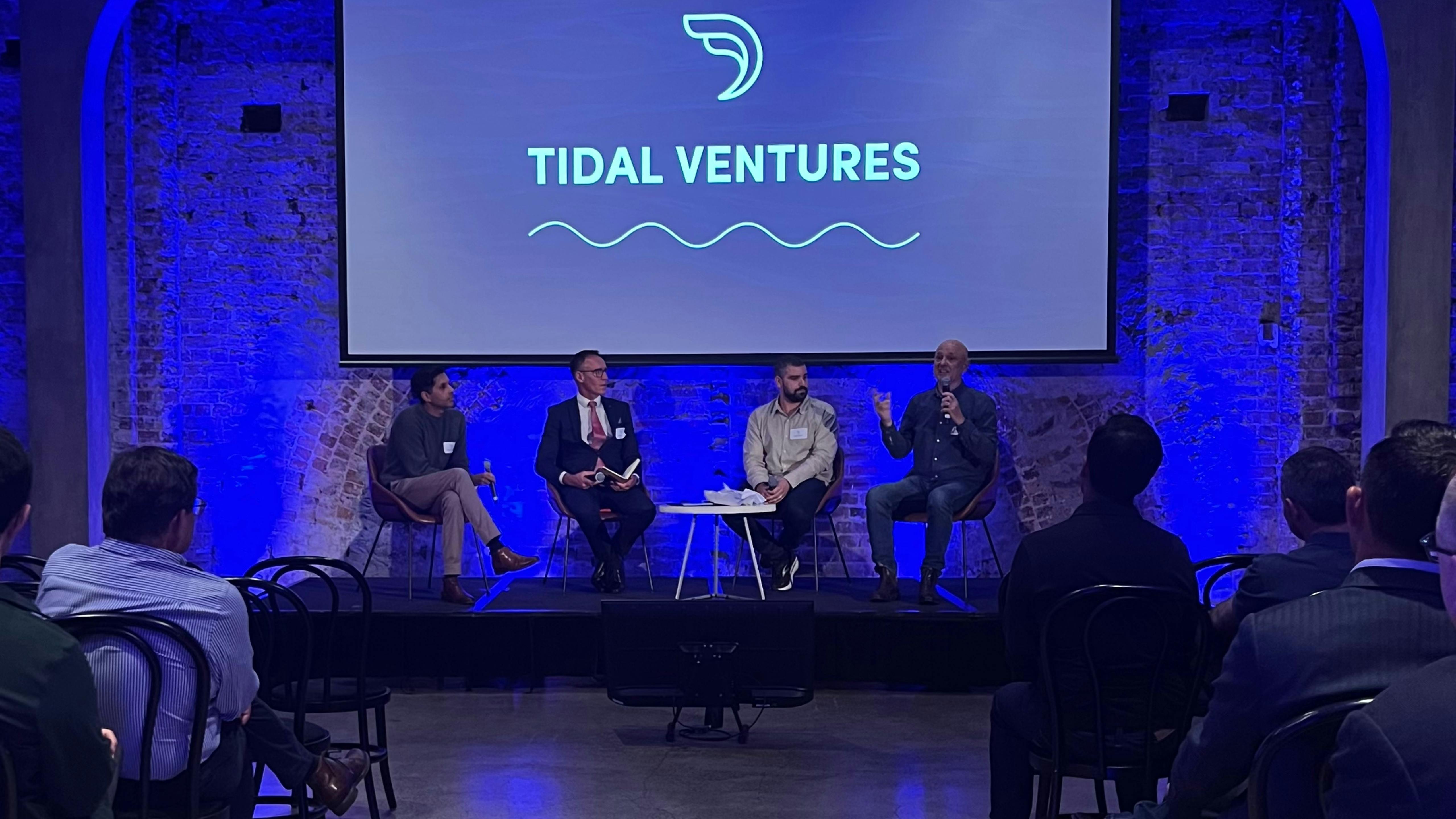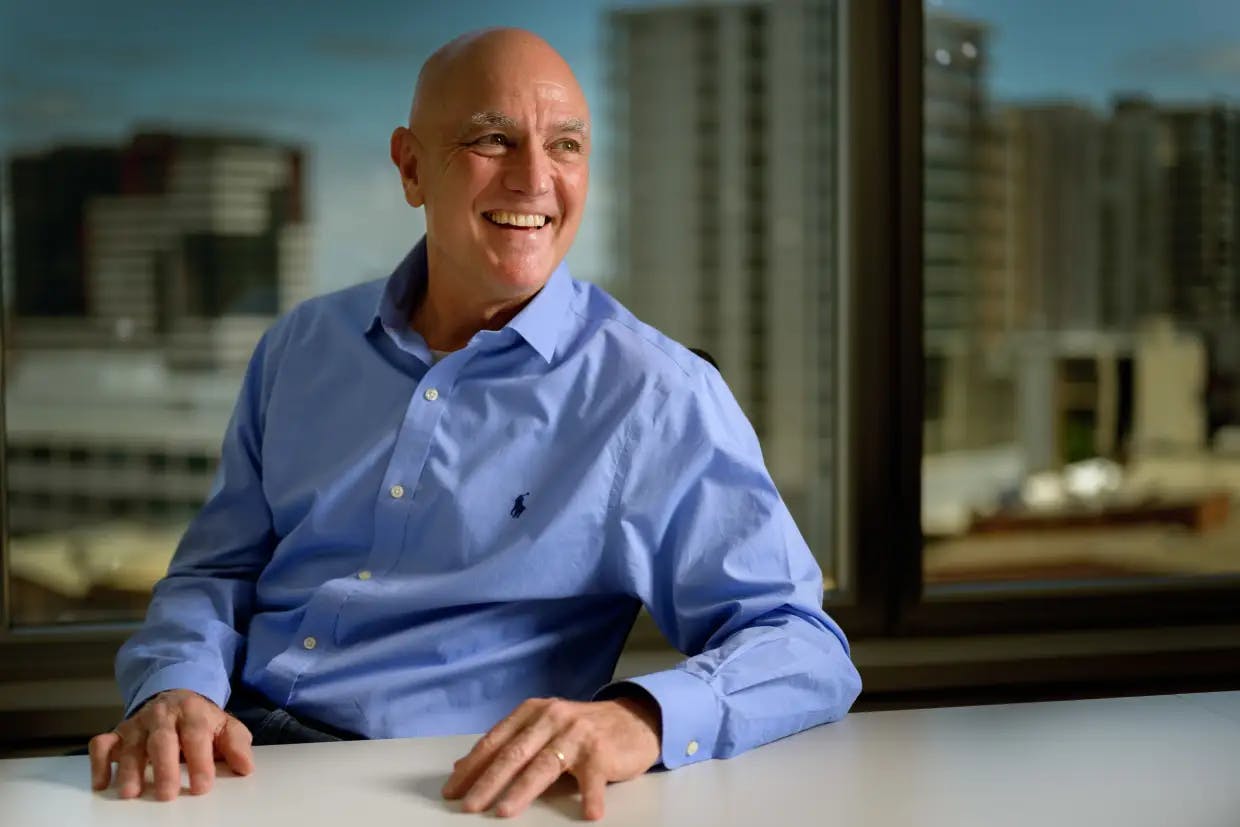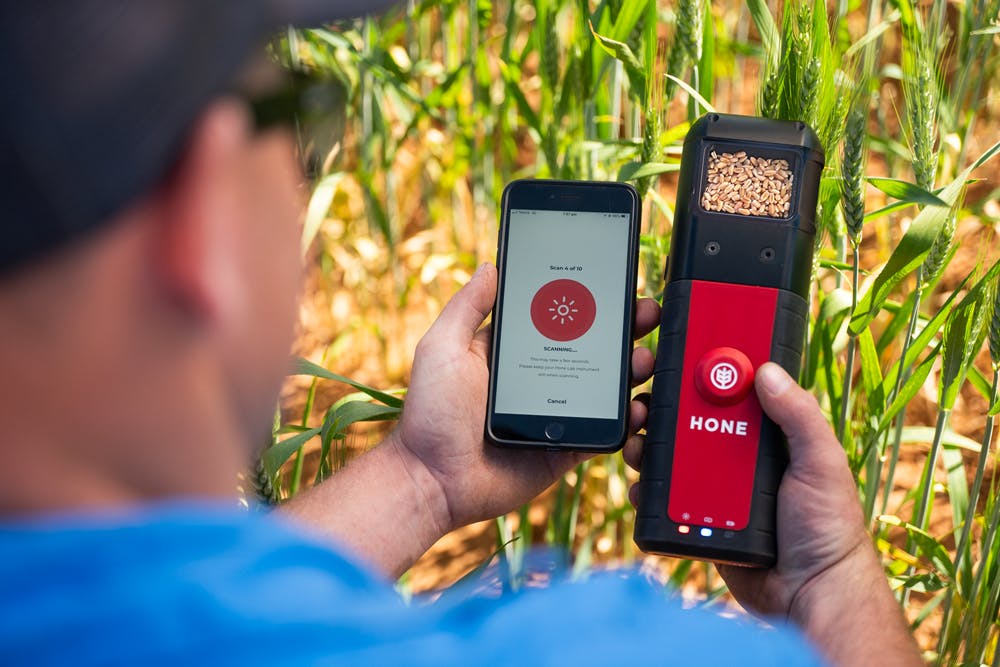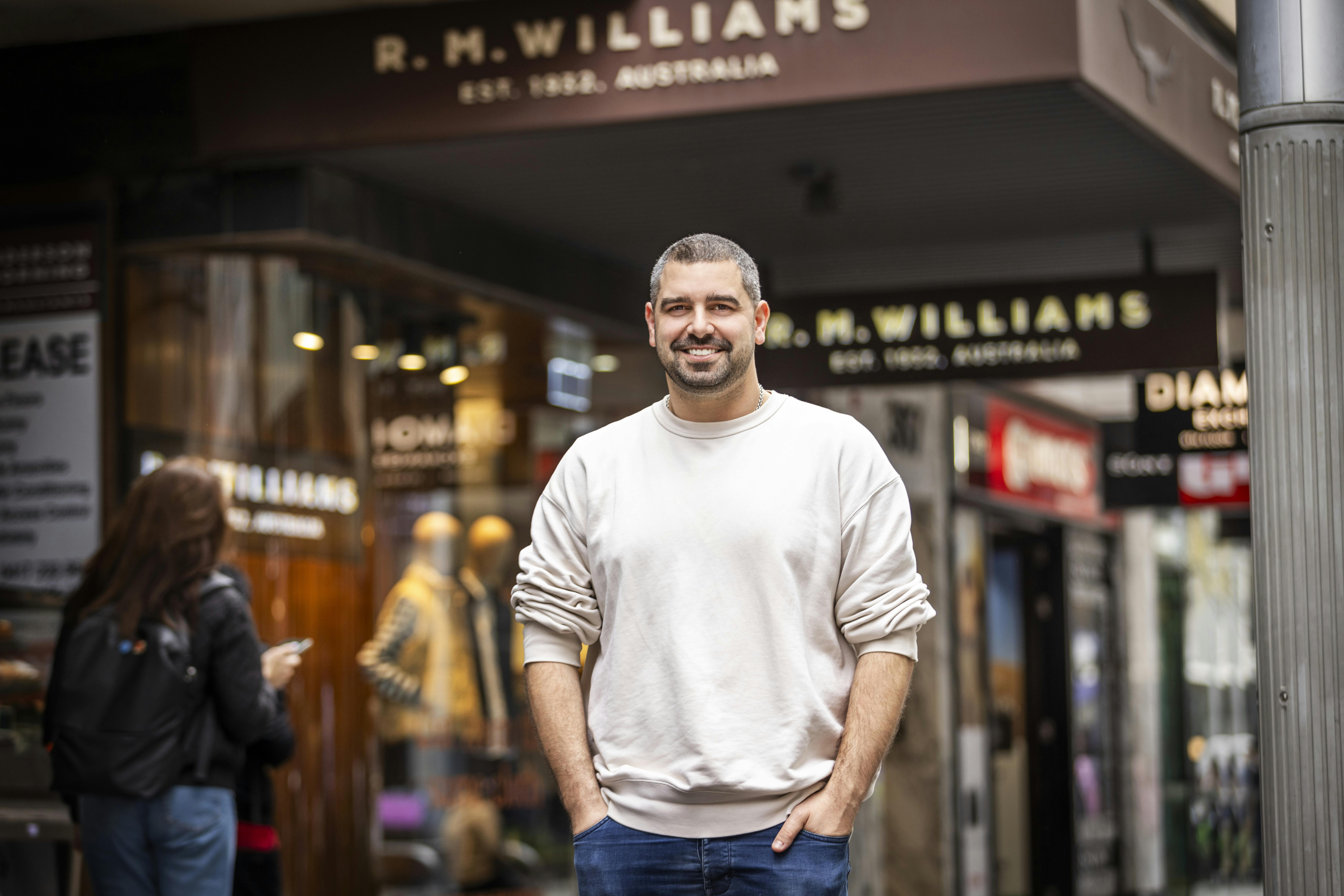Wave Makers
Unleashing the power of AI: Insights from Tidal Ventures’ portfolio leaders
Leaders from our portfolio companies Flagship, Hone, and Lifelenz explore the role of AI, discuss innovative strategies, and consider its potential to enhance overall product value.
23 Nov 2023 · 11 min read

The transformative impact of artificial intelligence (AI) on various industries is undeniable. Tidal Ventures Managing Partner Wendell Keuneman recently hosted a panel discussion featuring leaders from portfolio companies—Flagship, Hone, and Lifelenz. This insightful conversation delved into the role of AI in each company, the innovative strategies they are employing, and the potential for AI to enhance the overall value of their products.
Tidal managing partner Wendell Keuneman was joined by:
- Peter Johnston (PJ), Managing Director of Hone from Tidal Seed Fund I. PJ gets to “work in a cool bit of science called spectroscopy where we build chemometric models. We measure stuff, and we’re good at measuring stuff. Rather than having to bring it to a laboratory, we enable measurement in the field. We overcome the problem of distance for many agricultural producers and other industries where they need real-time information to make good decisions”.
- Simon Molnar, the founder of Tidal Seed Fund III portfolio company Flagship—a digital visual merchandising platform, indicates that they “basically help retailers place products in their store and work out the optimum placement of those products”. “So if you have a lot of stores in your store network, you have a lot of products in those stores, then you have to make sure that you’ve got the right products in the right stores and the right products in the right place”.
- Steve Kirkby, founder of Lifelenz from Tidal Follow-On Opportunity fund I highlights their focus on workforce management and labour optimisation, ultimately “getting the right person at the right time for certain industries”. Steve outlined their current focus on quick service restaurants, “If you know someone working at McDonald’s or KFC or Hungry Jacks in Australia, they’ll be using our app’.

Lifelenz founder, Steve Kirby
In a nutshell: What value AI unlocks
Hone
Hone’s ML engine accelerates the development of chemometric models, transforming what used to take weeks into a matter of hours. Moreover, it consistently produces more complex and robust models. With Hone’s cloud-based Machine Learning and AI, farmers can now make real-time decisions on grain segregation, optimising quality and yielding an average increase of 2% in farm gate values (net value of product after it’s left the farm).
Lifelenz
Lifelenz’s proprietary AI-powered forecasting model has established a global benchmark in labour scheduling, leading to a notable reduction in labour costs and a simultaneous boost in sales. This translates to a significant profitability enhancement, contributing up to 2% of EBITDA within the restaurant industry alone.
Flagship
Flagship’s AI-ready visual merchandising platform has significantly streamlined retail operations, cutting down manual efforts by two-thirds. This efficiency boost allows their workforce to redirect their efforts toward higher-impact tasks. Flagship anticipates substantial benefits for large retailers, estimating potential annual labour savings of 6,000 hours and an impressive 90% or more reduction in time to execution.
What role does AI play in each of your companies?
Hone
When it comes to Hone, Machine learning (ML) is core to what they do. As PJ indicated, “We’ve got these handheld spectrometers that farmers use where the machines collect raw spectrum, and then we run it through an ML engine and create calibrations from that data”. As Wendell astutely pointed out, “It’s always about behaviour change”. Hone has fundamentally changed behaviour around the process of chemical testing. Previously, chemical testing required two weeks to turn around, which resulted in expensive and infrequent testing, but with Hone’s cutting-edge hardware and software, they’re able to take a reading in the field rather than sending it back to the lab. “What that means is that frequency of testing becomes more common, more frequent, and as a result, the testing results in what we call currency—the economic value”, said Wendell.
The currency of Hone is the ability to understand yield right in the field. So they can start doing things like forecasting and uncovering the quality of that yield right then and there.
To illustrate this solution, consider GrainCorp who participated in Hone’s Series A funding round. They’re one of the largest grain traders in Canada and the US Eastern seaboard and faced a challenge due to the rapid growth of farms and machinery in recent years. Quicker harvests caused farmers to grapple with the issue of their headers filling up rapidly and requiring more frequent transportation. Historically, the header served as temporary storage for the grain before being transported to the depot where the machinery you need for grain quality inspections was usually held. To address this challenge, many on-farm storage facilities were constructed, and GrainCorp recognised the need to understand the quality of the grain closer to its point of harvest within these on-farm storage facilities. This became imperative as the traditional practice of testing the grain at the depot was no longer feasible. Enter Hone with their handheld spectrometers that farmers to collect raw spectrum that is then run through an ML engine and create calibrations from that data to help GrainCorp immediately understand the quality of each grain yield in the field.

Hone Lab Red handheld spectrometer grain analyser
Flagship
As Simon puts it, “I kind of see two different forms of AI. You’ve got internal AI and external AI”. At Flagship, “there’s a lot of ways that you can use it internally to create efficiencies. It takes a lot of the thinking effort away”, Simon says. Simon lists different uses like “creating outbound sales emails, replying to emails, generating content for us for taglines or LinkedIn posts, or you’ve got the engineering team using generative AI to create a framework for some code that they can then tweak, so a framework that would have taken them a significant amount of time now happens in a few seconds”.
From an external perspective, “we’re excited about how AI will continue to add value to our currency or value proposition”. Simon looks forward to instituting an AI capability that is “able to identify what products are working well in certain areas, what products aren’t working well in certain areas, and provide exceptional reporting or recommendations to optimise the layout of the store”. In the meantime, Simon touches on an AI capability that Flagship has started exploring “through our platform, we have images going back and forth between head office and their stores. We’ve started to run tests to map the directive image from the head office and the execution image from the store, highlight the differences between the images and give it a similarity score to identify if a store has executed correctly”.
Lifelenz
Lifelenz is known for its model that forecasts the “demand of a restaurant in 15-minute increments”; AI is at the core of this forecasting model. “Using our customers McDonald’s or KFC as an example. At every restaurant, 30 different models are running—including weather, local events, historical sales, and so on and AI is choosing from those 30 different models to say what they think the forecasted demand for this particular time is. The AI starts thinking about each 15-minute increment ten weeks out and is consistently self-learning and self-tuning. Steve highlights the true impact—“With precise forecasting, you can match your labour in a compliant manner to that forecasted outcome”. “In Australia alone, we’ve got over 2,000 restaurants with 30 models running every 15 minutes, meaning about 7 million models running a day coming up with these accurate forecasts, and we’ve been building our own with a model that optimises how the labour should be put into market”.
What impact does AI have on your customers?
Flagship
Simon Molnar reflects on the evolution of technology in the retail space: “There were a lot of different functions in the retail space where technology wasn’t an optimisation silver bullet, but I see this changing daily. Something as critical and labour-intensive as product descriptions can be created and optimised using AI. Now, with two clicks of a button, you can have all your content created for you. Or from a customer service perspective—you used to have a team of people at the ready to respond to customers because you needed that human-to-human interaction. Now, AI can formulate a sentence and create a conversation, and in many cases, the customer might not even know that they’re not speaking to a human.”
Simon Molnar challenges traditional notions in the industry: “A lot of people always thought that you needed people for visual merchandising. Humans physically go to each store to curate the layout and optimise the positioning of certain outfits. And as your business, your store network or even the size of your stores grew, you’d need more people—more people for a variety of roles including deciding how stores are going to look”. He highlights the transformative power of AI: “Now what we’re able to do is to create that underlying framework.”
Simon illustrates the practical applications: “So you have a new collection coming. You might know nothing about that collection or how it will perform, but every product has a product attribute. So, we can feed that into a pre-existing model and identify how attributes of each item are likely to perform and, as a result, where they should be placed. Head office no longer needs to wait weeks or months to amass the data to optimise a store; you can do that from the outset using historical comparisons.”
In conclusion, he emphasises the vast possibilities AI brings to Flagship’s offering: “That’s just one example of how Flagship will integrate AI into its offering, but the options are somewhat endless. There are so many different applications. It’s so versatile. And I would probably argue that there’s not a space or an industry that won’t be significantly impacted where some sort of efficiency is ripe for the taking.”
Simon illustrates this concept through a compelling example involving a US retailer with a sprawling network of 800 dispersed stores nationwide, currently employing 770 visual merchandisers, each earning an average of 75 to 85K USD annually. Simon emphasises the game-changing potential of Flagship for this retailer, stating, “By using Flagship, they can create automated directives based on real, localised data. They’ll likely be able to minimise their visual merchandising workforce needs by two-thirds, meaning their workforce can focus on higher-impact work.”
Providing essential context, Simon delves into the challenges businesses face in the vast and dispersed US market. He notes, “It’s near impossible to have people get out to every store because it’s so wide and spread out that you need that human manpower to get out to all the stores.” Simon wants to replace the traditional reliance on human labour for centralising and interpreting data and envisions a future where a self-evolving platform learns from its own contextual model, marking a significant departure from the current labour-intensive practices.
Continuing with his insightful perspective, Simon asserts, “I would say there’s a lot of industries that are going into a lot of roles that are going to be made faster in the same way that Excel would have made accountants faster.” He predicts a new wave of professions becoming more efficient, challenging the conventional belief that specific tasks inherently require a human touch. In Simon’s vision, the era of needing more people to handle increased revenue and store expansion is evolving. He signals a paradigm shift towards efficiency and automation in various industries.
Hone
Wendell asked PJ, “With agronomists and farmers testing more frequently, what is the real outcome when they can measure yield in the field?” To this, PJ responded, “We’ve been keenly watching what happens when technology and humans intersect.”
PJ then delved into the dynamic interplay of machine learning and human expertise, emphasising the unpredictable nature of an ML engine generating novel data. “An ML engine that produces novel data doesn’t have boundaries and can, therefore, be relatively unpredictable,” PJ explained. “But if you layer in a human who specialises in chemistry armed with a PhD, using AI to challenge their own hypotheses or assumptions, that’s a powerful situation to use AI to create a counterargument against the theory because that then gives you validation of whether it’s correct or not.”
Continuing the discussion, PJ highlighted the transformative impact on scientific validation, stating, “Previously, there was no way to do a peer review on a spectroscopy chemometric model across the last 65 years of spectroscopy and turn it around in 2 hours. And because that’s precisely what we do, we’re seeing an acceleration in our internal validation.”
As the conversation pivoted to the practical implications for Hone customers, PJ illustrated the potential for rapid decision-making. “Our customers that measure their grain quality can decide whether they put their grain in silo A, B, or C based on the quality within a short timeframe.” PJ further explored the scenario where widespread insights and AI applications enhance decision-making, stating, “What happens if all the grain on the Eastern seaboard within a district farmers had insights or machine learning and AI was laid over the top to say if farmer A takes grain from silo number one and mixes it with farmer B’s grain out of silo number five, the average value increases by $20 a ton.”
Lifelenz
Lifelenz, with its AI-powered forecasting capability, has garnered attention from executives seeking to reduce costs while adhering to compliant practices. Steve underscores the catalyst behind the increasing demand for Lifelenz, stating, “The C-suite is expressing considerable interest in Lifelenz, with a primary focus on labour optimisation. It goes beyond mere cost-cutting; it’s about ensuring the right person is scheduled at the right time, engaging in activities that ultimately enhance sales. This is a profit and loss driver, making it particularly appealing to the C-suite.” Additionally, The importance of the compliance framework has risen significantly among Lifelenz customers, given the intricate nature of industry compliance laws. Steve articulates, “Our software is gaining substantial attention because it automates processes and seamlessly integrates labour optimisation and compliance. Considering the substantial impact of labour costs, precision in this area is crucial for owner/operators.”
What is the most controversial part of AI for your customers?
Flagship
In the realm of retail, Simon sheds light on prevailing sentiment, noting, “I’ve seen a lot of fear and caution around AI taking people’s jobs. You can sense that wariness when we’re speaking to visual merchandisers.” Underscoring a widely acknowledged fact, he adds, “It’s no secret that when you have an intermediary function between two parties, there’s an opportunity for AI to disrupt. What I believe will be a bit more immune from an AI perspective is the human-to-human perspective. So any role, any service where it’s built on that human-to-human relationship is going to be a lot harder.”
In a nuanced perspective, Simon posits, “I could be eating my words in a couple of years, but I think the biggest piece that AI won’t be able to replace is how you make someone feel and the relationship and what you drive, and that emotion that you drive in someone. It’s why brands like Louis Vuitton, Chanel, and Gucci have built brands at such a premium price point: they’ve created an affinity and emotional connection with the brand. AI may be able to get you from A to B in terms of what you’re trying to achieve, but it’s yet to be seen whether it can evoke that same emotion that another human can.”

Flagship founder, Simon Molnar
Hone
Adding another layer to the discussion, PJ provides an intriguing viewpoint: “Humans are overly protective of their intellectual property—there’s a prevailing sentiment that going against me is not a wise bet; we’ve been doing this for 100 years. It’s about whether people will take the leap of faith and trust the technology. I place more trust in the reliability of science than I trust most people. In the long run, trusting in technology is an investment that will safeguard human error.”
Lifelenz
At the crux of the matter lies the issue of trust, a sentiment echoed by Steve at Lifelenz. The contentious element surfaces at the operational level, where the team needs to trust the algorithms’ outcomes. It becomes imperative for the team to comprehend the value that AI brings to both them and the business. Take generated schedules, for instance; Steve says, “A lot of senior leadership, such as owners, operators, or executives, will instruct their teams not to touch the schedules; they’re perfectly generated. But individuals within their teams think they know better, and we’ve found that they’re wrong 90% of the time.”
Steve further emphasises:
We’ve learned over time that people start trusting the AI when they allow the algorithms to drive the business forward and generate better outcomes. When the staff are getting reliable work, when they’re getting all the right money, when the platform makes sure people are doing the right roles, getting the right training, identifying people who are perhaps not as good managers as they should be because of higher churn in their teams, etc. They’re the outcomes that will change how businesses see the software because it starts running the business well.
Hone, Lifelenz, and Flagship exemplify the versatility of AI applications, from revolutionising agriculture practices to reshaping retail strategies and optimising workforce management. As highlighted by the leaders, the integration of AI enhances operational efficiencies, fosters innovation, transforms traditional processes and improves decision-making. While concerns about job displacement and the challenge of building trust in AI algorithms persist, the overall consensus is optimistic, foreseeing a future where AI becomes invaluable in driving business success and adapting to the evolving landscape of technology and human collaboration.
Subscribe to Tidal Ventures
Get our latest newsletters delivered right to your inbox
Our recent thought waves
Investment Notes: Tendl
Tendl is a game-changing AI platform revolutionising how companies approach tendering by transforming complex bid processes into streamlined, intelligent workflows. What traditionally takes days can now be completed in under an hour, saving companies tens of thousands of dollars annually.
Investment Notes: Minikai
We're thrilled to have led Minikai's Seed round, partnering with the team to revolutionise how care providers operate in highly regulated sectors through AI-powered automation. As your AI ally in disability and aged care, their platform transforms the workflow of frontline care providers by automating administrative work and compliance reporting, enabling them to focus more time on patient care while building a powerful trust platform between regulators and providers.
Investment Notes: AIMon
We’re thrilled to announce that we’ve co-led AIMon’s Pre-Seed round alongside Bessemer Venture Partners. AIMon is addressing one of AI’s most pressing challenges: ensuring Large Language Models (LLMs) are safe, reliable, and enterprise-ready. Their platform empowers organisations to deploy AI confidently, mitigating risks like hallucinations, harmful content, and data leakage.